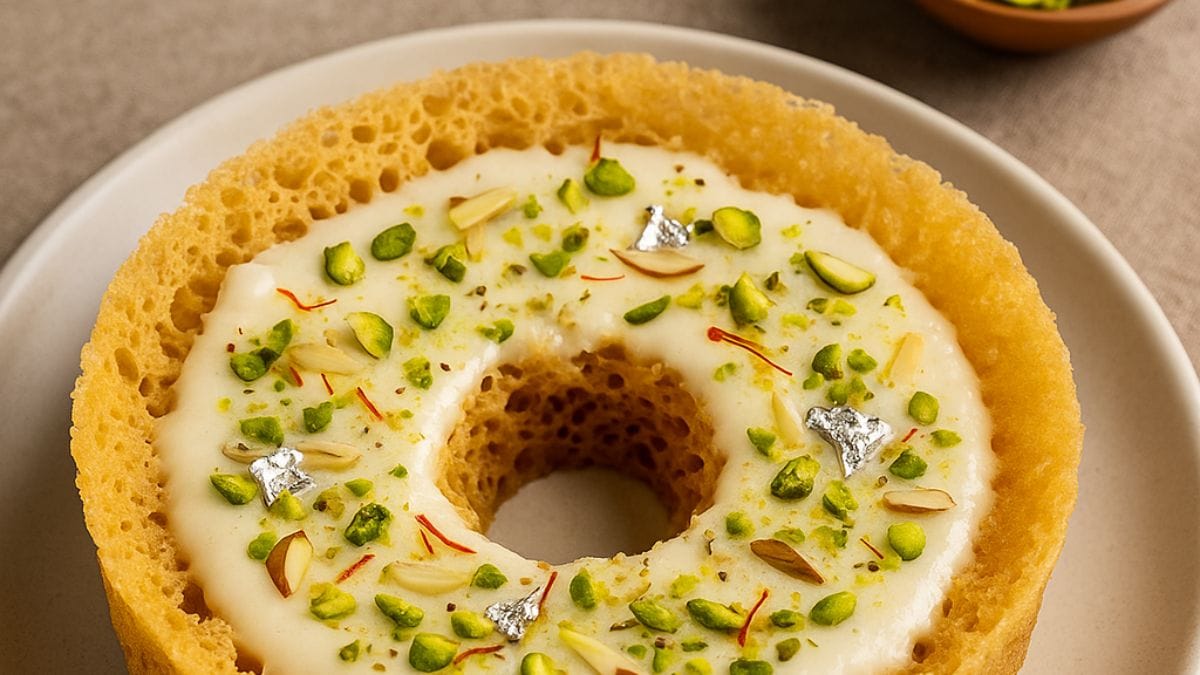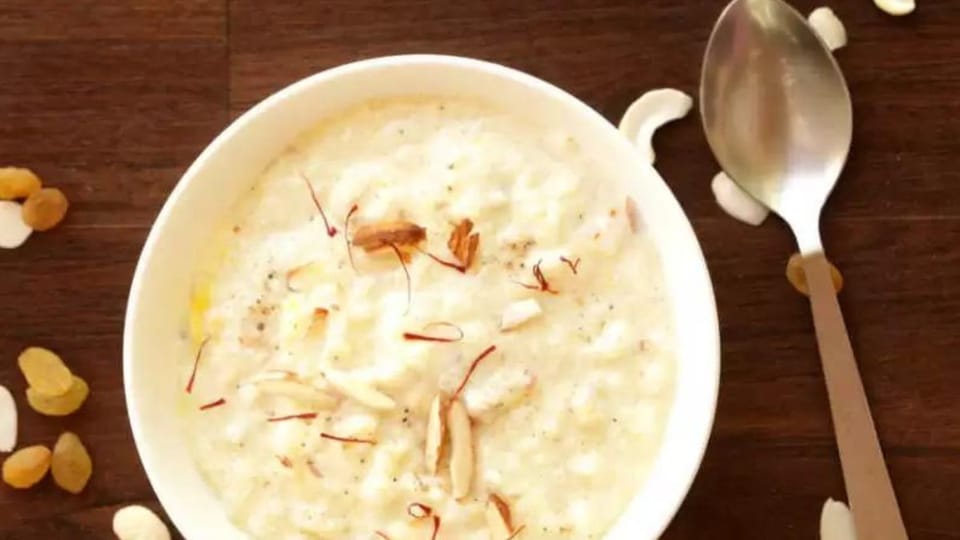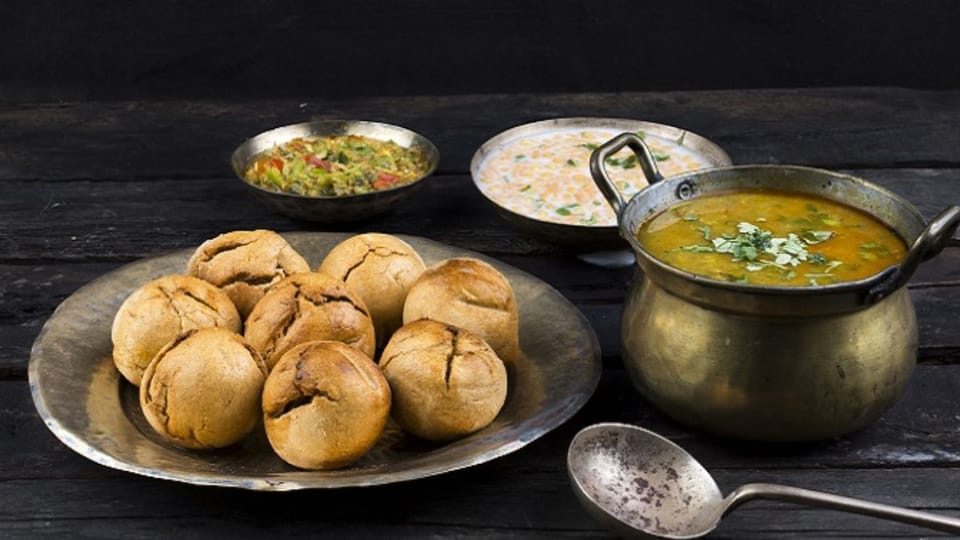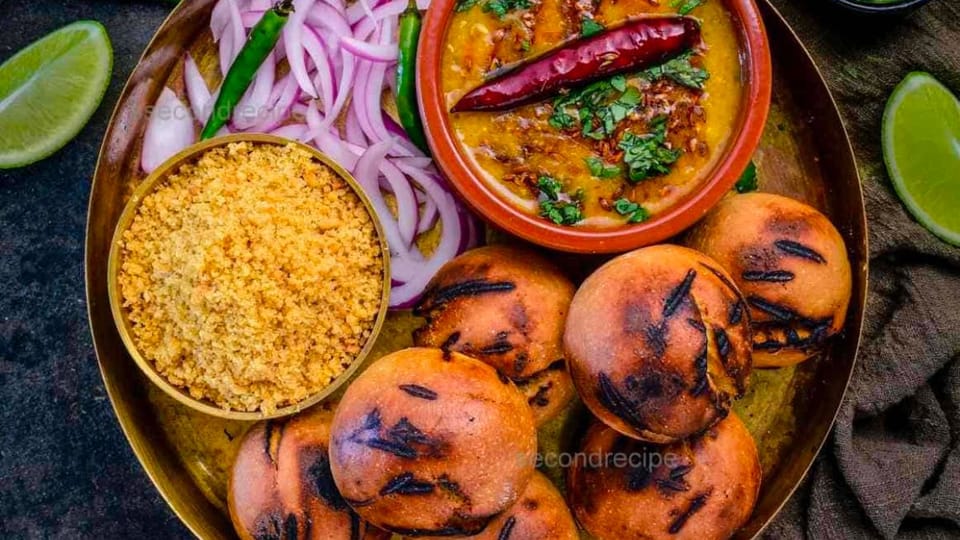Ghevar recipe: Traditional Rajasthani sweet dish loved during Teej and Raksha Bandhan

Discover everything you need to know—from its royal past and cultural symbolism to perfecting homemade Ghevar recipes this festive season.
What Is Ghevar?
Ghevar (also spelled Ghewar) is a disc-shaped, honeycomb-textured Rajasthani sweet made from maida (all-purpose flour), ghee, and often a touch of milk or besan (gram flour). Its light, crisp structure is achieved through a signature pouring method that creates web-like layers: a thin batter is poured over hot ghee in circular streams, forming a lacework of golden crispness. Once fried, the cake is soaked in sweet syrup and garnished with saffron, cardamom, and finely chopped nuts like almonds and pistachios.
It is deeply associated with the monsoon festivals of Teej and Raksha Bandhan, and holds ceremonial significance in traditions like Chhapan Bhog.
The Royal Roots of Ghevar
A Culinary Invention from Rajasthan
Though there’s debate over its exact birthplace, most food historians credit Rajasthan’s royal kitchens—especially in Jaipur and Marwar—with creating Ghevar centuries ago as an ornate dessert for Maharajas and nobles.
Why Monsoon Matters
It may sound counterintuitive, but Ghevar owes its crisp honeycomb structure to the moisture in the Shravan monsoon season. The ambient humidity helps the batter crisp up into the characteristic porous texture. For this reason, Ghevar is traditionally made only in July–August during the Teej-Raksha Bandhan window.
From Royal Courts to Village Sweets
Over time, what began as an exclusive culinary art transformed into a household staple in Rajasthan and neighbouring states—Haryana, Delhi, Gujarat, UP, and MP—with sweet shops churning out kilograms every monsoon.
Why Ghevar is so important in festivals
Teej and Raksha Bandhan: Ghevar’s Signature Moment
During Hariyali Teej and Raksha Bandhan, homemade and shop-bought Ghevar floods festival tables across North India. For sisters celebrating the bond with their brothers, gifting Ghevar has become a symbolic tradition.
Symbolic Shape, Symbolic Emotions
The circular form of Ghevar—without any beginning or end—is often taken to represent eternal relationships, while the layered structure mirrors the complex dynamics of familial bonds.
It’s Part of Religious Traditions
Ghevar even features in temple food traditions: for instance, as one of the Chhapan Bhog (56 offerings) to Lord Krishna at certain Vaishnava temples and during Gangaur celebrations.
Popular Variants of Ghevar
| Version | Unique Twist |
|---|---|
| Plain Ghevar | Crisp, honeycomb-textured, soaked in sugar syrup |
| Mawa/Rabdi Ghevar | Creamy topping, often saffron-infused |
| Malai Ghevar | Rich layer of thickened cream (malai), cardamom and nuts |
| Dry‑Fruit Ghevar | Loaded with chopped almonds, pistachios, and dried fruits |
| Multi‑Layer Ghevar | Several concentric rings, elaborately stacked |
| Chhena/Paneer Ghevar | A Jaipur speciality, made with fresh paneer, invented at LMB in 1961 |
| Sugar‑free / Keto Ghevar | Soaked in jaggery or sugar substitutes instead of sugar syrup |
In Jaipur, Laxmi Mishtan Bhandar (LMB) is famed for its chhena Ghevar; other cities offer regional adaptations like mango-, rabri-, or fruit-flavoured versions.
Step-by-Step Guide to Making Traditional Plain Ghevar
Prep Time: 30 mins | Cook Time: 40 min | Yield: 4–6 Ghevars
Ingredients:
- 1.5 cups all-purpose flour (maida)
- ½ cup ghee (clarified butter), plus oil/ghee for frying
- ½ cup chilled milk
- ~1.5 to 2 cups ice-cold water
- 1 to 1.5 cups sugar
- 1 cup water (for sugar syrup)
- A pinch of cardamom powder, saffron strands
- Slivered nuts (almonds, pistachios) for garnish
Method Summary:
- Beat the ghee and milk with ice cubes until the mixture turns white and creamy—this removes impurities and helps crisp up the batter.
- Stir in sifted maida, then gradually add cold water to whisk into a smooth, slightly runny batter—no lumps allowed.
- Heat ghee in a deep pan and test by dropping a tiny stream—if it floats and settles slowly, it's ready.
- Using a ladle or funnel, pour the batter from at least 5 inches above the oil, in concentric rings—this action creates the characteristic lace-like texture. Let it float and puff before frying until golden.
- Soak it in warm sugar syrup (one-string consistency)—a ratio of ~2:1 sugar to water is ideal—to ensure it absorbs enough sweetness without falling apart.
- Drain it, top with cardamom, saffron, and chopped nuts, then serve.
5 Tips for Perfect Ghevar (and Common Mistakes)
- Batter consistency matters—too thick and it won’t flow, too thin and it collapses.
- Use cold water in the batter; it helps prevent over-absorption of oil and creates a crisp result.
- Fry patiently—don’t press it down or force bubbles; let it cook evenly.
- Next step rest: after frying, let excess ghee drip off before syruping to avoid sogginess.
- Sugar syrup consistency is key: test using the thumb–finger “single string” method.
Nutrition & Storage Insights
- A typical plain Ghevar (≈50g) might contain 180–220 kcal, largely from carbohydrates and fat. Premium versions with rabdi or malai can exceed 300–350 kcal per piece.
- In dry climates, unsyruped Ghevar can stay crisp for up to a month; once soaked in syrup, it lasts 3–5 days depending on humidity.
- Sugar-free variations using jaggery, stevia, or sucralose are becoming more common for health-conscious consumers.
Ghevar’s Sweet Legacy
Ghevar delivers more than just sweetness; it is a symbol of tradition, celebration, and craftsmanship—from royal feasts to neighborhood mithai counters, especially during monsoon festivals like Teej and Raksha Bandhan. Its delicate honeycomb structure and rich syrupy taste continue to win hearts across generations. Whether you savor a simple plain Ghevar or indulge in malai‑topped variations, mastering it at home is a testament to festive cooking skills.
This monsoon, invite tradition to your kitchen—follow the classic recipe above, embrace your unique twist, and share the joy of Ghevar with loved ones. Happy Ghevar-making!
FAQs
Q: Can Ghevar be made ahead?
A: Unsyruped Ghevar can be stored up to a month in cool, dry weather. Once dipped in syrup, best to consume within 3–5 days.
Q: Why pour the batter from a height?
A: Dropping the batter from 5–6 inches into hot ghee creates the lace‑like texture that defines Ghevar.
Q: Is there any sugar-free version?
A: Yes—chefs today use jaggery, stevia, or keto-friendly sweeteners to make sugar-free or diabetic-friendly Ghevar.
Q: Can this be made without traditional doughnut moulds?
A: Yes—many home cooks use a funnel or ladle to pour the batter and achieve good structure without special rings.




